Example of OAuth2 Social Login in Spring Boot
1. Objective of Lesson
The traditional way to be experienced by users to access a protected website is that they need to create an account, and then enter their email to activate the account, memorize their username and password. Majority of users often forget this information after a period of time. The information that users have to enter to create an account sometimes makes them be discouraged.

Nowadays, Logging in a website through a social network is a quite common form, which is used by many websites. By this way, users can create an account on your websites fast. Your application doesn't also need to send an activation email to the users.
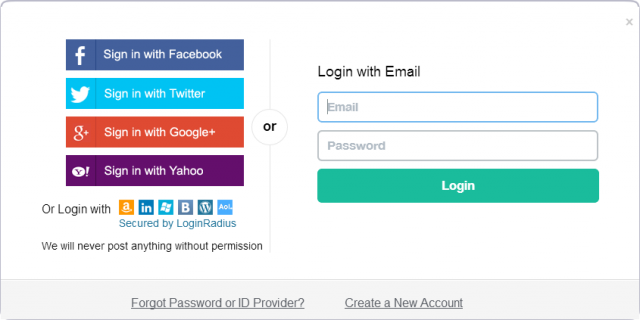
In the first time, users use their social network accounts to log in your website, you have 3 different choices to handle.
- Choice 1: Their social network account will be accepted, and your website doesn't do any other action.
- Choice 2: Based on the public information on user's social network account, your website automatically creates a corresponding account.
- Choice 3: Your Website redirects users to a registration page with default information obtained from their social network account, which helps users not to need to enter all information.
In this lesson, we are going to create an application with Spring Boot + JPA + Spring Social Security. Below is the preview image of the application.
CHOICE 2:
In case, users log in via social network for the first time, an APP_USER record will be created automatically with an automatical User_Name created by the system.
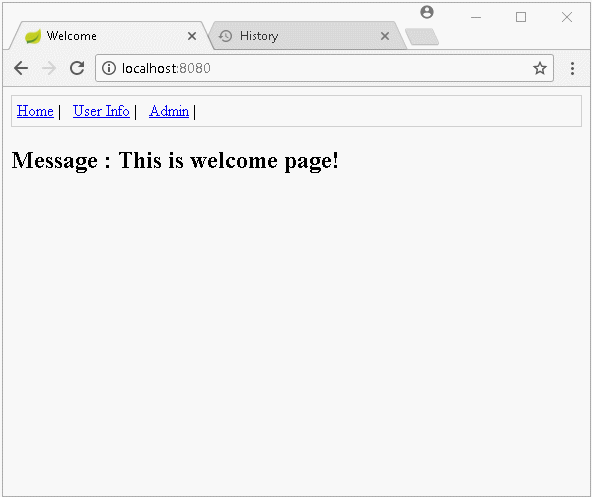
CHOICE 3:
If users log in via social network for the first time and the system redirects them to a registration page with default information obtained from their social network account, they can change the information such as User_Name, First Name, Last Name , ... And then they press "Submit", an APP_USER record will be created.
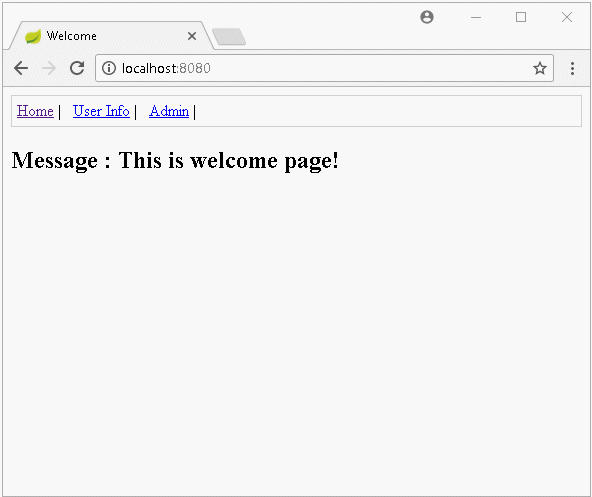
2. Create a Spring Boot project
On the Eclipse, create a Spring Boot project.
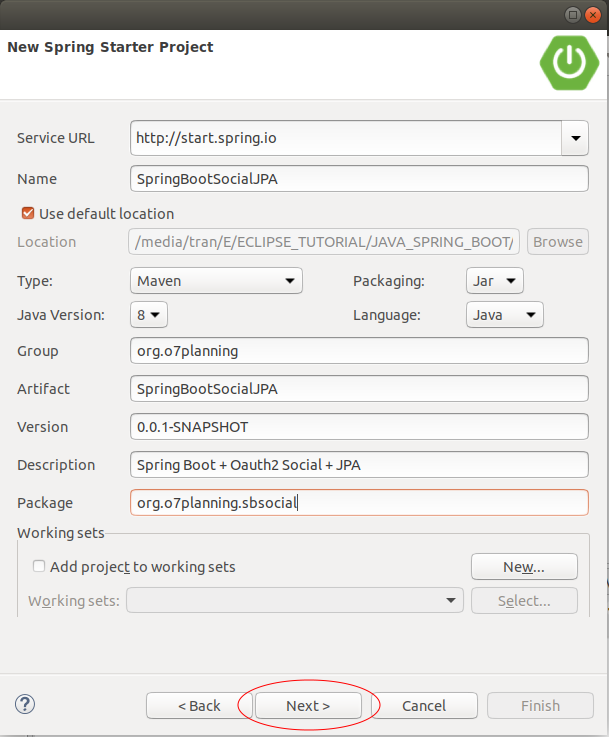
The database used in this application is MySQL, SQL Server, PostGres orOracle or any other database that you are familiar with.
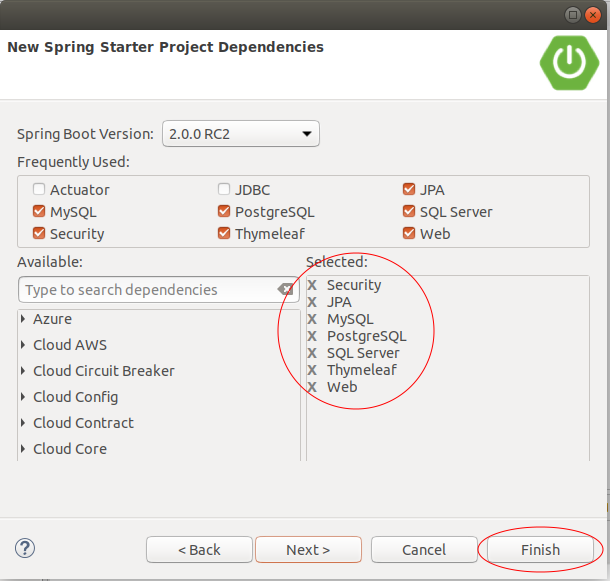
Declare Spring Social libraries in your project:
- spring-security-oauth2
- spring-social-core
- spring-social-config
- spring-social-security
- spring-social-facebook
- spring-social-twitter
- spring-social-github
- spring-social-linkedin
- spring-social-google
The full content of pom.xml file:
pom.xml
<?xml version="1.0" encoding="UTF-8"?>
<project xmlns="http://maven.apache.org/POM/4.0.0"
xmlns:xsi="http://www.w3.org/2001/XMLSchema-instance"
xsi:schemaLocation="http://maven.apache.org/POM/4.0.0
http://maven.apache.org/xsd/maven-4.0.0.xsd">
<modelVersion>4.0.0</modelVersion>
<groupId>org.o7planning</groupId>
<artifactId>SpringBootSocialJPA</artifactId>
<version>0.0.1-SNAPSHOT</version>
<packaging>jar</packaging>
<name>SpringBootSocialJPA</name>
<description>Spring Boot + Oauth2 Social + JPA</description>
<parent>
<groupId>org.springframework.boot</groupId>
<artifactId>spring-boot-starter-parent</artifactId>
<version>2.0.0.RELEASE</version>
<relativePath /> <!-- lookup parent from repository -->
</parent>
<properties>
<project.build.sourceEncoding>UTF-8</project.build.sourceEncoding>
<project.reporting.outputEncoding>UTF-8</project.reporting.outputEncoding>
<java.version>1.8</java.version>
</properties>
<dependencies>
<dependency>
<groupId>org.springframework.boot</groupId>
<artifactId>spring-boot-starter-data-jpa</artifactId>
</dependency>
<dependency>
<groupId>org.springframework.boot</groupId>
<artifactId>spring-boot-starter-security</artifactId>
</dependency>
<dependency>
<groupId>org.springframework.boot</groupId>
<artifactId>spring-boot-starter-thymeleaf</artifactId>
</dependency>
<dependency>
<groupId>org.springframework.boot</groupId>
<artifactId>spring-boot-starter-web</artifactId>
</dependency>
<!-- http://mvnrepository.com/artifact/org.springframework.security/spring-security-config -->
<dependency>
<groupId>org.springframework.security</groupId>
<artifactId>spring-security-config</artifactId>
</dependency>
<!-- https://mvnrepository.com/artifact/org.springframework.security.oauth/spring-security-oauth2 -->
<dependency>
<groupId>org.springframework.security.oauth</groupId>
<artifactId>spring-security-oauth2</artifactId>
<version>2.2.1.RELEASE</version>
</dependency>
<!-- https://mvnrepository.com/artifact/org.springframework.social/spring-social-core -->
<dependency>
<groupId>org.springframework.social</groupId>
<artifactId>spring-social-core</artifactId>
<version>1.1.5.RELEASE</version>
</dependency>
<!-- https://mvnrepository.com/artifact/org.springframework.social/spring-social-config -->
<dependency>
<groupId>org.springframework.social</groupId>
<artifactId>spring-social-config</artifactId>
<version>1.1.5.RELEASE</version>
</dependency>
<!-- https://mvnrepository.com/artifact/org.springframework.social/spring-social-web -->
<dependency>
<groupId>org.springframework.social</groupId>
<artifactId>spring-social-web</artifactId>
<version>1.1.5.RELEASE</version>
</dependency>
<!-- https://mvnrepository.com/artifact/org.springframework.social/spring-social-security -->
<dependency>
<groupId>org.springframework.social</groupId>
<artifactId>spring-social-security</artifactId>
<version>1.1.5.RELEASE</version>
</dependency>
<!-- https://mvnrepository.com/artifact/org.springframework.social/spring-social-facebook -->
<dependency>
<groupId>org.springframework.social</groupId>
<artifactId>spring-social-facebook</artifactId>
<version>2.0.3.RELEASE</version>
</dependency>
<!-- https://mvnrepository.com/artifact/org.springframework.social/spring-social-twitter -->
<dependency>
<groupId>org.springframework.social</groupId>
<artifactId>spring-social-twitter</artifactId>
<version>1.1.2.RELEASE</version>
</dependency>
<!-- https://mvnrepository.com/artifact/org.springframework.social/spring-social-github -->
<!-- <dependency>
<groupId>org.springframework.social</groupId>
<artifactId>spring-social-github</artifactId>
<version>1.0.0.M4</version>
</dependency> -->
<!-- https://mvnrepository.com/artifact/org.springframework.social/spring-social-linkedin -->
<dependency>
<groupId>org.springframework.social</groupId>
<artifactId>spring-social-linkedin</artifactId>
<version>1.0.2.RELEASE</version>
</dependency>
<!-- https://mvnrepository.com/artifact/org.springframework.social/spring-social-google -->
<dependency>
<groupId>org.springframework.social</groupId>
<artifactId>spring-social-google</artifactId>
<version>1.0.0.RELEASE</version>
</dependency>
<dependency>
<groupId>mysql</groupId>
<artifactId>mysql-connector-java</artifactId>
<scope>runtime</scope>
</dependency>
<dependency>
<groupId>org.postgresql</groupId>
<artifactId>postgresql</artifactId>
<scope>runtime</scope>
</dependency>
<dependency>
<groupId>com.oracle</groupId>
<artifactId>ojdbc6</artifactId>
<version>11.2.0.3</version>
</dependency>
<!-- SQL Server Mssql-Jdbc Driver -->
<dependency>
<groupId>com.microsoft.sqlserver</groupId>
<artifactId>mssql-jdbc</artifactId>
<scope>runtime</scope>
</dependency>
<!-- SQL Server JTDS Driver -->
<!-- https://mvnrepository.com/artifact/net.sourceforge.jtds/jtds -->
<dependency>
<groupId>net.sourceforge.jtds</groupId>
<artifactId>jtds</artifactId>
<version>1.3.1</version>
</dependency>
<!-- Email validator,... -->
<!-- http://mvnrepository.com/artifact/commons-validator/commons-validator%20 -->
<dependency>
<groupId>commons-validator</groupId>
<artifactId>commons-validator</artifactId>
<version>1.5.0</version>
</dependency>
<dependency>
<groupId>org.springframework.boot</groupId>
<artifactId>spring-boot-starter-test</artifactId>
<scope>test</scope>
</dependency>
<dependency>
<groupId>org.springframework.security</groupId>
<artifactId>spring-security-test</artifactId>
<scope>test</scope>
</dependency>
</dependencies>
<repositories>
<!-- Repository for ORACLE JDBC Driver -->
<repository>
<id>codelds</id>
<url>https://code.lds.org/nexus/content/groups/main-repo</url>
</repository>
</repositories>
<build>
<plugins>
<plugin>
<groupId>org.springframework.boot</groupId>
<artifactId>spring-boot-maven-plugin</artifactId>
</plugin>
</plugins>
</build>
</project>SpringBootSocialJpaApplication.java
package org.o7planning.sbsocial;
import org.springframework.boot.SpringApplication;
import org.springframework.boot.autoconfigure.SpringBootApplication;
@SpringBootApplication
public class SpringBootSocialJpaApplication {
public static void main(String[] args) {
SpringApplication.run(SpringBootSocialJpaApplication.class, args);
}
}3. Configure DataSource
The information on the database to be configured in the application.properties file:
application.properties (MySQL)
spring.thymeleaf.cache=false
# ===============================
# DATABASE
# ===============================
spring.datasource.driver-class-name=com.mysql.jdbc.Driver
spring.datasource.url=jdbc:mysql://localhost:3306/social
spring.datasource.username=root
spring.datasource.password=12345
# ===============================
# JPA / HIBERNATE
# ===============================
spring.jpa.show-sql=true
spring.jpa.hibernate.ddl-auto=update
spring.jpa.properties.hibernate.dialect=org.hibernate.dialect.MySQL5Dialectapplication.properties (Mssql-Jdbc Driver)
spring.thymeleaf.cache=false
# ===============================
# DATABASE
# ===============================
spring.datasource.driver-class-name=com.microsoft.sqlserver.jdbc.SQLServerDriver
spring.datasource.url=jdbc:sqlserver://tran-vmware-pc\\SQLEXPRESS:1433;databaseName=social
spring.datasource.username=sa
spring.datasource.password=12345
# ===============================
# JPA / HIBERNATE
# ===============================
spring.jpa.show-sql=true
spring.jpa.hibernate.ddl-auto=update
spring.jpa.properties.hibernate.dialect=org.hibernate.dialect.SQLServer2012Dialectapplication.properties (PostGres)
spring.thymeleaf.cache=false
# ===============================
# DATABASE CONNECTION
# ===============================
spring.datasource.driver-class-name=org.postgresql.Driver
spring.datasource.url=jdbc:postgresql://tran-vmware-pc:5432/social
spring.datasource.username=postgres
spring.datasource.password=12345
# ===============================
# JPA / HIBERNATE
# ===============================
spring.jpa.show-sql=true
spring.jpa.hibernate.ddl-auto=update
spring.jpa.properties.hibernate.dialect=org.hibernate.dialect.PostgreSQLDialect
# Fix Postgres JPA Error:
# Method org.postgresql.jdbc.PgConnection.createClob() is not yet implemented.
spring.jpa.properties.hibernate.temp.use_jdbc_metadata_defaults=falseapplication.properties (Oracle)
spring.thymeleaf.cache=false
# ===============================
# DATABASE
# ===============================
spring.datasource.driver-class-name=oracle.jdbc.driver.OracleDriver
spring.datasource.url=jdbc:oracle:thin:@localhost:1521:db12c
spring.datasource.username=social
spring.datasource.password=12345
# ===============================
# JPA / HIBERNATE
# ===============================
spring.jpa.show-sql=true
spring.jpa.hibernate.ddl-auto=update
spring.jpa.properties.hibernate.dialect=org.hibernate.dialect.Oracle10gDialect4. Configure Security & Spring Social
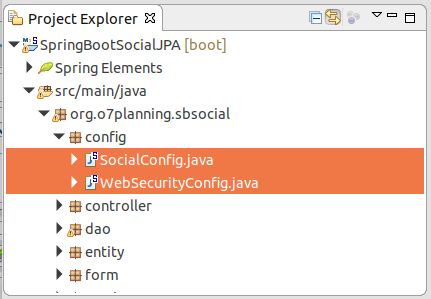
Configure Spring Security:
WebSecurityConfig.java
package org.o7planning.sbsocial.config;
import org.o7planning.sbsocial.entity.AppRole;
import org.springframework.beans.factory.annotation.Autowired;
import org.springframework.context.annotation.Configuration;
import org.springframework.security.config.annotation.authentication.builders.AuthenticationManagerBuilder;
import org.springframework.security.config.annotation.web.builders.HttpSecurity;
import org.springframework.security.config.annotation.web.configuration.EnableWebSecurity;
import org.springframework.security.config.annotation.web.configuration.WebSecurityConfigurerAdapter;
import org.springframework.security.core.userdetails.UserDetailsService;
import org.springframework.social.security.SpringSocialConfigurer;
@Configuration
@EnableWebSecurity
public class WebSecurityConfig extends WebSecurityConfigurerAdapter {
@Autowired
private UserDetailsService userDetailsService;
@Autowired
public void configureGlobal(AuthenticationManagerBuilder auth) throws Exception {
auth.userDetailsService(userDetailsService);
}
@Override
protected void configure(HttpSecurity http) throws Exception {
http.csrf().disable();
// Pages do not require login
http.authorizeRequests().antMatchers("/", "/signup", "/login", "/logout").permitAll();
http.authorizeRequests().antMatchers("/userInfo").access("hasRole('" + AppRole.ROLE_USER + "')");
// For ADMIN only.
http.authorizeRequests().antMatchers("/admin").access("hasRole('" + AppRole.ROLE_ADMIN + "')");
// When the user has logged in as XX.
// But access a page that requires role YY,
// AccessDeniedException will be thrown.
http.authorizeRequests().and().exceptionHandling().accessDeniedPage("/403");
// Form Login config
http.authorizeRequests().and().formLogin()//
// Submit URL of login page.
.loginProcessingUrl("/j_spring_security_check") // Submit URL
.loginPage("/login")//
.defaultSuccessUrl("/userInfo")//
.failureUrl("/login?error=true")//
.usernameParameter("username")//
.passwordParameter("password");
// Logout Config
http.authorizeRequests().and().logout().logoutUrl("/logout").logoutSuccessUrl("/");
// Spring Social Config.
http.apply(new SpringSocialConfigurer())
//
.signupUrl("/signup");
}
// This bean is load the user specific data when form login is used.
@Override
public UserDetailsService userDetailsService() {
return userDetailsService;
}
}For users to be able to register your website through social network, on each social network, you need to register OAuth2 certificates. After the registration, you will have a pair of "Key + Password". Please declare this pair of key and password into the social-cfg.properties file:
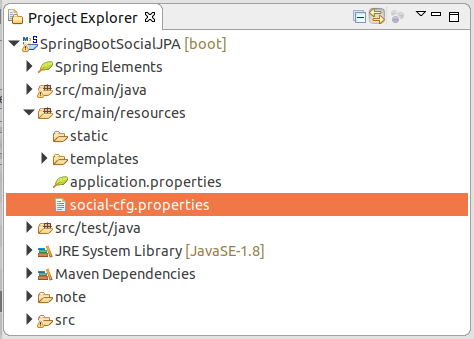
I have registered the OAuth2 certificates below so that this application can log in via some common social networks. But, it works only if this application runs on http://localhost:8080. In case, you run the application on other domains or ports, you must register your own certificates.
social-cfg.properties
social.auto-signup=false
# Google
# http://localhost:8080/auth/google
google.client.id=160790488111-he5fn6rq0foqg05te70dk25gifeoum9s.apps.googleusercontent.com
google.client.secret=VILTmX1UjOnyw2_meYvDQEdl
google.scope=https://www.googleapis.com/auth/userinfo.email https://www.googleapis.com/auth/userinfo.profile
# Facebook
# http://localhost:8080/auth/facebook
facebook.app.id=1084911261562762
facebook.app.secret=81a324fdbc4cade1ee25523c7bff58b3
facebook.scope=public_profile,email
# Twitter
# http://localhost:8080/auth/twitter
twitter.consumer.key=
twitter.consumer.secret=
twitter.scope=
# Linkedin
# http://localhost:8080/auth/linkedin
linkedin.consumer.key=...
linkedin.consumer.secret=...
linkedin.scope=The social-cfg.properties file will be read in the SocialConfig class.
Note: social.auto-signup property:
- social.auto-signup=true: means that when an user logs in via social network for the first time, an APP_USER record will be created automatically.
- social.auto-signup=false: means that when an user logs in via social network for the first time, the application will redirect him/her to a registration page, with default information, he/she can change this information, and then press "Submit". At this moment, a new APP_USER record is created.
SocialConfig.java
package org.o7planning.sbsocial.config;
import javax.sql.DataSource;
import org.o7planning.sbsocial.dao.AppUserDAO;
import org.o7planning.sbsocial.social.ConnectionSignUpImpl;
import org.springframework.beans.factory.annotation.Autowired;
import org.springframework.context.annotation.Bean;
import org.springframework.context.annotation.Configuration;
import org.springframework.context.annotation.PropertySource;
import org.springframework.core.env.Environment;
import org.springframework.security.crypto.encrypt.Encryptors;
import org.springframework.social.UserIdSource;
import org.springframework.social.config.annotation.ConnectionFactoryConfigurer;
import org.springframework.social.config.annotation.EnableSocial;
import org.springframework.social.config.annotation.SocialConfigurer;
import org.springframework.social.connect.ConnectionFactoryLocator;
import org.springframework.social.connect.ConnectionRepository;
import org.springframework.social.connect.ConnectionSignUp;
import org.springframework.social.connect.UsersConnectionRepository;
import org.springframework.social.connect.jdbc.JdbcUsersConnectionRepository;
import org.springframework.social.connect.web.ConnectController;
import org.springframework.social.facebook.connect.FacebookConnectionFactory;
import org.springframework.social.google.connect.GoogleConnectionFactory;
import org.springframework.social.linkedin.connect.LinkedInConnectionFactory;
import org.springframework.social.security.AuthenticationNameUserIdSource;
import org.springframework.social.twitter.connect.TwitterConnectionFactory;
@Configuration
@EnableSocial
// Load to Environment.
@PropertySource("classpath:social-cfg.properties")
public class SocialConfig implements SocialConfigurer {
private boolean autoSignUp = false;
@Autowired
private DataSource dataSource;
@Autowired
private AppUserDAO appUserDAO;
// @env: read from social-cfg.properties file.
@Override
public void addConnectionFactories(ConnectionFactoryConfigurer cfConfig, Environment env) {
try {
this.autoSignUp = Boolean.parseBoolean(env.getProperty("social.auto-signup"));
} catch (Exception e) {
this.autoSignUp = false;
}
// Twitter
TwitterConnectionFactory tfactory = new TwitterConnectionFactory(//
env.getProperty("twitter.consumer.key"), //
env.getProperty("twitter.consumer.secret"));
// tfactory.setScope(env.getProperty("twitter.scope"));
cfConfig.addConnectionFactory(tfactory);
// Facebook
FacebookConnectionFactory ffactory = new FacebookConnectionFactory(//
env.getProperty("facebook.app.id"), //
env.getProperty("facebook.app.secret"));
ffactory.setScope(env.getProperty("facebook.scope"));
// auth_type=reauthenticate
cfConfig.addConnectionFactory(ffactory);
// Linkedin
LinkedInConnectionFactory lfactory = new LinkedInConnectionFactory(//
env.getProperty("linkedin.consumer.key"), //
env.getProperty("linkedin.consumer.secret"));
lfactory.setScope(env.getProperty("linkedin.scope"));
cfConfig.addConnectionFactory(lfactory);
// Google
GoogleConnectionFactory gfactory = new GoogleConnectionFactory(//
env.getProperty("google.client.id"), //
env.getProperty("google.client.secret"));
gfactory.setScope(env.getProperty("google.scope"));
cfConfig.addConnectionFactory(gfactory);
}
// The UserIdSource determines the userID of the user.
@Override
public UserIdSource getUserIdSource() {
return new AuthenticationNameUserIdSource();
}
// USERCONNECTION.
@Override
public UsersConnectionRepository getUsersConnectionRepository(ConnectionFactoryLocator connectionFactoryLocator) {
// org.springframework.social.security.SocialAuthenticationServiceRegistry
JdbcUsersConnectionRepository usersConnectionRepository = new JdbcUsersConnectionRepository(dataSource,
connectionFactoryLocator,
Encryptors.noOpText());
if (autoSignUp) {
// After logging in to social networking.
// Automatically creates corresponding APP_USER if it does not exist.
ConnectionSignUp connectionSignUp = new ConnectionSignUpImpl(appUserDAO);
usersConnectionRepository.setConnectionSignUp(connectionSignUp);
} else {
// After logging in to social networking.
// If the corresponding APP_USER record is not found.
// Navigate to registration page.
usersConnectionRepository.setConnectionSignUp(null);
}
return usersConnectionRepository;
}
// This bean manages the connection flow between the account provider
// and the example application.
@Bean
public ConnectController connectController(ConnectionFactoryLocator connectionFactoryLocator, //
ConnectionRepository connectionRepository) {
return new ConnectController(connectionFactoryLocator, connectionRepository);
}
}See also way for registering OAuth2 certificates with some different social networks:
5. Entity & DAO
When you run this application for the first time, tables will be created based on entities.
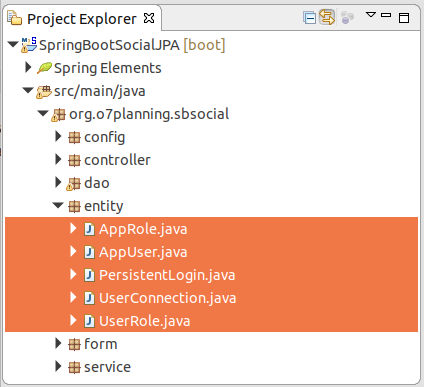
The USERCONNECTION table will be created based on the UserConnection class. This table will be used automatically by Spring Social API. It stores user's public information obtained from the social network such as ProviderId, ProviderUserId, Displayname, Imageurl, ... You must not change the structure of this table.
UserConnection.java
package org.o7planning.sbsocial.entity;
import java.io.Serializable;
import javax.persistence.Column;
import javax.persistence.Entity;
import javax.persistence.Id;
import javax.persistence.Table;
@Entity
@Table(name = "Userconnection")
public class UserConnection implements Serializable {
private static final long serialVersionUID = -6991752510891411572L;
@Id
@Column(name = "Userid", length = 255, nullable = false)
private String userId;
@Id
@Column(name = "Providerid", length = 255, nullable = false)
private String providerId;
@Id
@Column(name = "Provideruserid", length = 255, nullable = false)
private String providerUserId;
@Column(name = "Rank", nullable = false)
private int rank;
@Column(name = "Displayname", length = 255, nullable = true)
private String displayName;
@Column(name = "Profileurl", length = 512, nullable = true)
private String profileUrl;
@Column(name = "Imageurl", length = 512, nullable = true)
private String imageUrl;
@Column(name = "Accesstoken", length = 512, nullable = true)
private String accessToken;
@Column(name = "Secret", length = 512, nullable = true)
private String secret;
@Column(name = "Refreshtoken", length = 512, nullable = true)
private String refreshToken;
@Column(name = "Expiretime", nullable = true)
private Long expireTime;
public String getUserId() {
return userId;
}
public void setUserId(String userId) {
this.userId = userId;
}
public String getProviderId() {
return providerId;
}
public void setProviderId(String providerId) {
this.providerId = providerId;
}
public String getProviderUserId() {
return providerUserId;
}
public void setProviderUserId(String providerUserId) {
this.providerUserId = providerUserId;
}
public int getRank() {
return rank;
}
public void setRank(int rank) {
this.rank = rank;
}
public String getDisplayName() {
return displayName;
}
public void setDisplayName(String displayName) {
this.displayName = displayName;
}
public String getProfileUrl() {
return profileUrl;
}
public void setProfileUrl(String profileUrl) {
this.profileUrl = profileUrl;
}
public String getImageUrl() {
return imageUrl;
}
public void setImageUrl(String imageUrl) {
this.imageUrl = imageUrl;
}
public String getAccessToken() {
return accessToken;
}
public void setAccessToken(String accessToken) {
this.accessToken = accessToken;
}
public String getSecret() {
return secret;
}
public void setSecret(String secret) {
this.secret = secret;
}
public String getRefreshToken() {
return refreshToken;
}
public void setRefreshToken(String refreshToken) {
this.refreshToken = refreshToken;
}
public Long getExpireTime() {
return expireTime;
}
public void setExpireTime(Long expireTime) {
this.expireTime = expireTime;
}
}The PERSISTENT_LOGINS table will be created based on the PersistentLogin class. This table will be used automatically by theSpring Security Remember Me. You mustn't change the structure of this table.
PersistentLogin.java
package org.o7planning.sbsocial.entity;
import java.util.Date;
import javax.persistence.Column;
import javax.persistence.Entity;
import javax.persistence.Id;
import javax.persistence.Table;
import javax.persistence.Temporal;
import javax.persistence.TemporalType;
@Entity
@Table(name = "persistent_logins")
public class PersistentLogin {
@Id
@Column(name = "Series", length = 64, nullable = false)
private String series;
@Column(name = "Username", length = 64, nullable = false)
private String userName;
@Column(name = "Token", length = 64, nullable = false)
private String token;
@Temporal(TemporalType.TIMESTAMP)
@Column(name = "Last_Used", nullable = false)
private Date lastUsed;
public String getSeries() {
return series;
}
public void setSeries(String series) {
this.series = series;
}
public String getUserName() {
return userName;
}
public void setUserName(String userName) {
this.userName = userName;
}
public String getToken() {
return token;
}
public void setToken(String token) {
this.token = token;
}
public Date getLastUsed() {
return lastUsed;
}
public void setLastUsed(Date lastUsed) {
this.lastUsed = lastUsed;
}
}The APP_USER, APP_ROLE, USER_ROLE table willbe created automatically based onAppUser, AppRole, UserRole classes:
AppUser.java
package org.o7planning.sbsocial.entity;
import javax.persistence.Column;
import javax.persistence.Entity;
import javax.persistence.GeneratedValue;
import javax.persistence.Id;
import javax.persistence.Table;
import javax.persistence.UniqueConstraint;
@Entity
@Table(name = "App_User", //
uniqueConstraints = { //
@UniqueConstraint(name = "APP_USER_UK", columnNames = "User_Name"),
@UniqueConstraint(name = "APP_USER_UK2", columnNames = "Email") })
public class AppUser {
@Id
@GeneratedValue
@Column(name = "User_Id", nullable = false)
private Long userId;
@Column(name = "User_Name", length = 36, nullable = false)
private String userName;
@Column(name = "Email", length = 128, nullable = false)
private String email;
@Column(name = "First_Name", length = 36, nullable = true)
private String firstName;
@Column(name = "Last_Name", length = 36, nullable = true)
private String lastName;
@Column(name = "Encryted_Password", length = 128, nullable = false)
private String encrytedPassword;
@Column(name = "Enabled", length = 1, nullable = false)
private boolean enabled;
public Long getUserId() {
return userId;
}
public void setUserId(Long userId) {
this.userId = userId;
}
public String getUserName() {
return userName;
}
public void setUserName(String userName) {
this.userName = userName;
}
public String getEmail() {
return email;
}
public void setEmail(String email) {
this.email = email;
}
public String getFirstName() {
return firstName;
}
public void setFirstName(String firstName) {
this.firstName = firstName;
}
public String getLastName() {
return lastName;
}
public void setLastName(String lastName) {
this.lastName = lastName;
}
public String getEncrytedPassword() {
return encrytedPassword;
}
public void setEncrytedPassword(String encrytedPassword) {
this.encrytedPassword = encrytedPassword;
}
public boolean isEnabled() {
return enabled;
}
public void setEnabled(boolean enabled) {
this.enabled = enabled;
}
}AppRole.java
package org.o7planning.sbsocial.entity;
import javax.persistence.Column;
import javax.persistence.Entity;
import javax.persistence.GeneratedValue;
import javax.persistence.Id;
import javax.persistence.Table;
import javax.persistence.UniqueConstraint;
@Entity
@Table(name = "App_Role", //
uniqueConstraints = { //
@UniqueConstraint(name = "APP_ROLE_UK", columnNames = "Role_Name") })
public class AppRole {
public static final String ROLE_USER = "ROLE_USER";
public static final String ROLE_ADMIN = "ROLE_ADMIN";
@Id
@GeneratedValue
@Column(name = "Role_Id", nullable = false)
private Long roleId;
@Column(name = "Role_Name", length = 30, nullable = false)
private String roleName;
public Long getRoleId() {
return roleId;
}
public void setRoleId(Long roleId) {
this.roleId = roleId;
}
public String getRoleName() {
return roleName;
}
public void setRoleName(String roleName) {
this.roleName = roleName;
}
}UserRole.java
package org.o7planning.sbsocial.entity;
import javax.persistence.Column;
import javax.persistence.Entity;
import javax.persistence.FetchType;
import javax.persistence.GeneratedValue;
import javax.persistence.Id;
import javax.persistence.JoinColumn;
import javax.persistence.ManyToOne;
import javax.persistence.Table;
import javax.persistence.UniqueConstraint;
@Entity
@Table(name = "User_Role", //
uniqueConstraints = { //
@UniqueConstraint(name = "USER_ROLE_UK", //
columnNames = { "User_Id", "Role_Id" }) })
public class UserRole {
@Id
@GeneratedValue
@Column(name = "Id", nullable = false)
private Long id;
@ManyToOne(fetch = FetchType.LAZY)
@JoinColumn(name = "User_Id", nullable = false)
private AppUser appUser;
@ManyToOne(fetch = FetchType.LAZY)
@JoinColumn(name = "Role_Id", nullable = false)
private AppRole appRole;
public Long getId() {
return id;
}
public void setId(Long id) {
this.id = id;
}
public AppUser getAppUser() {
return appUser;
}
public void setAppUser(AppUser appUser) {
this.appUser = appUser;
}
public AppRole getAppRole() {
return appRole;
}
public void setAppRole(AppRole appRole) {
this.appRole = appRole;
}
}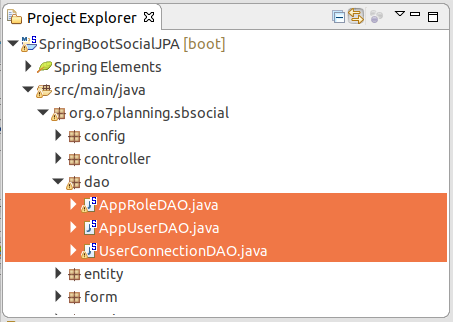
AppUserDAO.java
package org.o7planning.sbsocial.dao;
import java.util.ArrayList;
import java.util.List;
import java.util.UUID;
import javax.persistence.EntityManager;
import javax.persistence.NoResultException;
import javax.persistence.Query;
import org.o7planning.sbsocial.entity.AppRole;
import org.o7planning.sbsocial.entity.AppUser;
import org.o7planning.sbsocial.form.AppUserForm;
import org.o7planning.sbsocial.utils.EncrytedPasswordUtils;
import org.springframework.beans.factory.annotation.Autowired;
import org.springframework.social.connect.Connection;
import org.springframework.social.connect.ConnectionKey;
import org.springframework.social.connect.UserProfile;
import org.springframework.stereotype.Repository;
import org.springframework.transaction.annotation.Transactional;
@Repository
@Transactional
public class AppUserDAO {
@Autowired
private EntityManager entityManager;
@Autowired
private AppRoleDAO appRoleDAO;
public AppUser findAppUserByUserId(Long userId) {
try {
String sql = "Select e from " + AppUser.class.getName() + " e " //
+ " Where e.userId = :userId ";
Query query = entityManager.createQuery(sql, AppUser.class);
query.setParameter("userId", userId);
return (AppUser) query.getSingleResult();
} catch (NoResultException e) {
return null;
}
}
public AppUser findAppUserByUserName(String userName) {
try {
String sql = "Select e from " + AppUser.class.getName() + " e " //
+ " Where e.userName = :userName ";
Query query = entityManager.createQuery(sql, AppUser.class);
query.setParameter("userName", userName);
return (AppUser) query.getSingleResult();
} catch (NoResultException e) {
return null;
}
}
public AppUser findByEmail(String email) {
try {
String sql = "Select e from " + AppUser.class.getName() + " e " //
+ " Where e.email = :email ";
Query query = entityManager.createQuery(sql, AppUser.class);
query.setParameter("email", email);
return (AppUser) query.getSingleResult();
} catch (NoResultException e) {
return null;
}
}
private String findAvailableUserName(String userName_prefix) {
AppUser account = this.findAppUserByUserName(userName_prefix);
if (account == null) {
return userName_prefix;
}
int i = 0;
while (true) {
String userName = userName_prefix + "_" + i++;
account = this.findAppUserByUserName(userName);
if (account == null) {
return userName;
}
}
}
// Auto create App User Account.
public AppUser createAppUser(Connection<?> connection) {
ConnectionKey key = connection.getKey();
// (facebook,12345), (google,123) ...
System.out.println("key= (" + key.getProviderId() + "," + key.getProviderUserId() + ")");
UserProfile userProfile = connection.fetchUserProfile();
String email = userProfile.getEmail();
AppUser appUser = this.findByEmail(email);
if (appUser != null) {
return appUser;
}
String userName_prefix = userProfile.getFirstName().trim().toLowerCase()//
+ "_" + userProfile.getLastName().trim().toLowerCase();
String userName = this.findAvailableUserName(userName_prefix);
//
// Random Password! TODO: Need send email to User!
//
String randomPassword = UUID.randomUUID().toString().substring(0, 5);
String encrytedPassword = EncrytedPasswordUtils.encrytePassword(randomPassword);
//
appUser = new AppUser();
appUser.setEnabled(true);
appUser.setEncrytedPassword(encrytedPassword);
appUser.setUserName(userName);
appUser.setEmail(email);
appUser.setFirstName(userProfile.getFirstName());
appUser.setLastName(userProfile.getLastName());
this.entityManager.persist(appUser);
// Create default Role
List<String> roleNames = new ArrayList<String>();
roleNames.add(AppRole.ROLE_USER);
this.appRoleDAO.createRoleFor(appUser, roleNames);
return appUser;
}
public AppUser registerNewUserAccount(AppUserForm appUserForm, List<String> roleNames) {
AppUser appUser = new AppUser();
appUser.setUserName(appUserForm.getUserName());
appUser.setEmail(appUserForm.getEmail());
appUser.setFirstName(appUserForm.getFirstName());
appUser.setLastName(appUserForm.getLastName());
appUser.setEnabled(true);
String encrytedPassword = EncrytedPasswordUtils.encrytePassword(appUserForm.getPassword());
appUser.setEncrytedPassword(encrytedPassword);
this.entityManager.persist(appUser);
this.entityManager.flush();
this.appRoleDAO.createRoleFor(appUser, roleNames);
return appUser;
}
}AppRoleDAO.java
package org.o7planning.sbsocial.dao;
import java.util.List;
import javax.persistence.EntityManager;
import javax.persistence.NoResultException;
import javax.persistence.Query;
import org.o7planning.sbsocial.entity.AppRole;
import org.o7planning.sbsocial.entity.AppUser;
import org.o7planning.sbsocial.entity.UserRole;
import org.springframework.beans.factory.annotation.Autowired;
import org.springframework.stereotype.Repository;
import org.springframework.transaction.annotation.Transactional;
@Repository
@Transactional
public class AppRoleDAO {
@Autowired
private EntityManager entityManager;
public List<String> getRoleNames(Long userId) {
String sql = "Select ur.appRole.roleName from " + UserRole.class.getName() + " ur " //
+ " where ur.appUser.userId = :userId ";
Query query = this.entityManager.createQuery(sql, String.class);
query.setParameter("userId", userId);
return query.getResultList();
}
public AppRole findAppRoleByName(String roleName) {
try {
String sql = "Select e from " + AppRole.class.getName() + " e " //
+ " where e.roleName = :roleName ";
Query query = this.entityManager.createQuery(sql, AppRole.class);
query.setParameter("roleName", roleName);
return (AppRole) query.getSingleResult();
} catch (NoResultException e) {
return null;
}
}
public void createRoleFor(AppUser appUser, List<String> roleNames) {
//
for (String roleName : roleNames) {
AppRole role = this.findAppRoleByName(roleName);
if (role == null) {
role = new AppRole();
role.setRoleName(AppRole.ROLE_USER);
this.entityManager.persist(role);
this.entityManager.flush();
}
UserRole userRole = new UserRole();
userRole.setAppRole(role);
userRole.setAppUser(appUser);
this.entityManager.persist(userRole);
this.entityManager.flush();
}
}
}UserConnectionDAO.java
package org.o7planning.sbsocial.dao;
import java.util.List;
import javax.persistence.EntityManager;
import javax.persistence.NoResultException;
import javax.persistence.Query;
import org.o7planning.sbsocial.entity.UserConnection;
import org.springframework.beans.factory.annotation.Autowired;
import org.springframework.stereotype.Repository;
import org.springframework.transaction.annotation.Transactional;
@Repository
@Transactional
public class UserConnectionDAO {
@Autowired
private EntityManager entityManager;
public UserConnection findUserConnectionByUserProviderId(String userProviderId) {
try {
String sql = "Select e from " + UserConnection.class.getName() + " e " //
+ " Where e.userProviderId = :userProviderId ";
Query query = entityManager.createQuery(sql, UserConnection.class);
query.setParameter("userProviderId", userProviderId);
List<UserConnection> list = query.getResultList();
return list.isEmpty() ? null : list.get(0);
} catch (NoResultException e) {
return null;
}
}
}6. Services & Utility
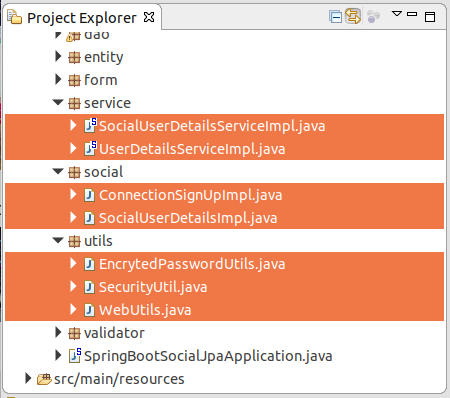
UserDetailsServiceImpl.java
package org.o7planning.sbsocial.service;
import java.util.ArrayList;
import java.util.List;
import org.o7planning.sbsocial.dao.AppRoleDAO;
import org.o7planning.sbsocial.dao.AppUserDAO;
import org.o7planning.sbsocial.entity.AppUser;
import org.o7planning.sbsocial.social.SocialUserDetailsImpl;
import org.springframework.beans.factory.annotation.Autowired;
import org.springframework.security.core.GrantedAuthority;
import org.springframework.security.core.authority.SimpleGrantedAuthority;
import org.springframework.security.core.userdetails.UserDetails;
import org.springframework.security.core.userdetails.UserDetailsService;
import org.springframework.security.core.userdetails.UsernameNotFoundException;
import org.springframework.stereotype.Service;
import org.springframework.transaction.annotation.Transactional;
@Service
@Transactional
public class UserDetailsServiceImpl implements UserDetailsService {
@Autowired
private AppUserDAO appUserDAO;
@Autowired
private AppRoleDAO appRoleDAO;
@Override
public UserDetails loadUserByUsername(String userName) throws UsernameNotFoundException {
System.out.println("UserDetailsServiceImpl.loadUserByUsername=" + userName);
AppUser appUser = this.appUserDAO.findAppUserByUserName(userName);
if (appUser == null) {
System.out.println("User not found! " + userName);
throw new UsernameNotFoundException("User " + userName + " was not found in the database");
}
System.out.println("Found User: " + appUser);
// [ROLE_USER, ROLE_ADMIN,..]
List<String> roleNames = this.appRoleDAO.getRoleNames(appUser.getUserId());
List<GrantedAuthority> grantList = new ArrayList<GrantedAuthority>();
if (roleNames != null) {
for (String role : roleNames) {
// ROLE_USER, ROLE_ADMIN,..
GrantedAuthority authority = new SimpleGrantedAuthority(role);
grantList.add(authority);
}
}
SocialUserDetailsImpl userDetails = new SocialUserDetailsImpl(appUser, roleNames);
return userDetails;
}
}SocialUserDetailsServiceImpl.java
package org.o7planning.sbsocial.service;
import org.o7planning.sbsocial.social.SocialUserDetailsImpl;
import org.springframework.beans.factory.annotation.Autowired;
import org.springframework.dao.DataAccessException;
import org.springframework.security.core.userdetails.UserDetails;
import org.springframework.security.core.userdetails.UserDetailsService;
import org.springframework.security.core.userdetails.UsernameNotFoundException;
import org.springframework.social.security.SocialUserDetails;
import org.springframework.social.security.SocialUserDetailsService;
import org.springframework.stereotype.Service;
@Service
public class SocialUserDetailsServiceImpl implements SocialUserDetailsService {
@Autowired
private UserDetailsService userDetailService;
// After user created by ConnectionSignUpImpl.execute(Connection<?>)
// This method is called by the Spring Social API.
@Override
public SocialUserDetails loadUserByUserId(String userName) throws UsernameNotFoundException, DataAccessException {
System.out.println("SocialUserDetailsServiceImpl.loadUserByUserId=" + userName);
// See UserDetailServiceImpl.
UserDetails userDetails = ((UserDetailsServiceImpl) userDetailService).loadUserByUsername(userName);
return (SocialUserDetailsImpl) userDetails;
}
}When an user logs in with his/her social network account for the first time, the application will get a Connection object. This object contains the user' Profile. You will write code in the ConnectionSignUpImpl class to create a record of the APP_USER table. (See also code in the SocialConfig class).
ConnectionSignUpImpl.java
package org.o7planning.sbsocial.social;
import org.o7planning.sbsocial.dao.AppUserDAO;
import org.o7planning.sbsocial.entity.AppUser;
import org.springframework.social.connect.Connection;
import org.springframework.social.connect.ConnectionSignUp;
public class ConnectionSignUpImpl implements ConnectionSignUp {
private AppUserDAO appUserDAO;
public ConnectionSignUpImpl(AppUserDAO appUserDAO) {
this.appUserDAO = appUserDAO;
}
// After logging in social networking.
// This method will be called to create a corresponding App_User record
// if it does not already exist.
@Override
public String execute(Connection<?> connection) {
AppUser account = appUserDAO.createAppUser(connection);
return account.getUserName();
}
}SocialUserDetailsImpl.java
package org.o7planning.sbsocial.social;
import java.util.ArrayList;
import java.util.Collection;
import java.util.List;
import org.o7planning.sbsocial.entity.AppUser;
import org.springframework.security.core.GrantedAuthority;
import org.springframework.security.core.authority.SimpleGrantedAuthority;
import org.springframework.social.security.SocialUserDetails;
public class SocialUserDetailsImpl implements SocialUserDetails {
private static final long serialVersionUID = -5246117266247684905L;
private List<GrantedAuthority> list = new ArrayList<GrantedAuthority>();
private AppUser appUser;
public SocialUserDetailsImpl(AppUser appUser, List<String> roleNames) {
this.appUser = appUser;
for (String roleName : roleNames) {
GrantedAuthority grant = new SimpleGrantedAuthority(roleName );
this.list.add(grant);
}
}
@Override
public String getUserId() {
return this.appUser.getUserId() + "";
}
@Override
public String getUsername() {
return appUser.getUserName();
}
@Override
public Collection<? extends GrantedAuthority> getAuthorities() {
return list;
}
@Override
public String getPassword() {
return appUser.getEncrytedPassword();
}
@Override
public boolean isAccountNonExpired() {
return true;
}
@Override
public boolean isAccountNonLocked() {
return true;
}
@Override
public boolean isCredentialsNonExpired() {
return true;
}
@Override
public boolean isEnabled() {
return true;
}
}EncrytedPasswordUtils.java
package org.o7planning.sbsocial.utils;
import org.springframework.security.crypto.bcrypt.BCryptPasswordEncoder;
public class EncrytedPasswordUtils {
// Encryte Password with BCryptPasswordEncoder
public static String encrytePassword(String password) {
BCryptPasswordEncoder encoder = new BCryptPasswordEncoder();
return encoder.encode(password);
}
}The SecurityUtil class contains utility methods to automatically log an user in the application.
SecurityUtil.java
package org.o7planning.sbsocial.utils;
import java.util.List;
import org.o7planning.sbsocial.entity.AppUser;
import org.o7planning.sbsocial.social.SocialUserDetailsImpl;
import org.springframework.security.authentication.UsernamePasswordAuthenticationToken;
import org.springframework.security.core.Authentication;
import org.springframework.security.core.context.SecurityContextHolder;
import org.springframework.social.security.SocialUserDetails;
public class SecurityUtil {
// Auto Login.
public static void logInUser(AppUser user, List<String> roleNames) {
SocialUserDetails userDetails = new SocialUserDetailsImpl(user, roleNames);
Authentication authentication = new UsernamePasswordAuthenticationToken(userDetails, null,
userDetails.getAuthorities());
SecurityContextHolder.getContext().setAuthentication(authentication);
}
}WebUtils.java
package org.o7planning.sbsocial.utils;
import java.util.Collection;
import org.springframework.security.core.GrantedAuthority;
import org.springframework.security.core.userdetails.UserDetails;
public class WebUtils {
public static String toString(UserDetails user) {
StringBuilder sb = new StringBuilder();
sb.append("UserName:").append(user.getUsername());
Collection<? extends GrantedAuthority> authorities = user.getAuthorities();
if (authorities != null && !authorities.isEmpty()) {
sb.append(" (");
boolean first = true;
for (GrantedAuthority a : authorities) {
if (first) {
sb.append(a.getAuthority());
first = false;
} else {
sb.append(", ").append(a.getAuthority());
}
}
sb.append(")");
}
return sb.toString();
}
}7. Form, Validator, Controller
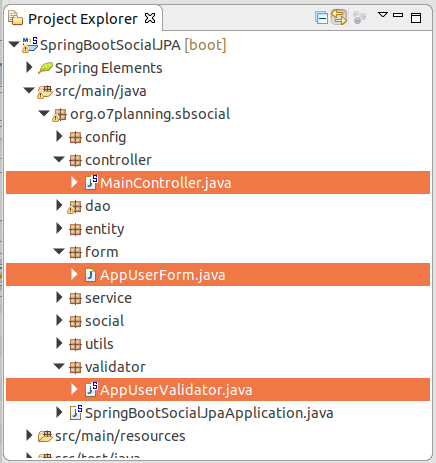
AppUserForm is a class that represents the data to be entered by users when registering a new account.
AppUserForm.java
package org.o7planning.sbsocial.form;
import org.springframework.social.connect.Connection;
import org.springframework.social.connect.ConnectionKey;
import org.springframework.social.connect.UserProfile;
public class AppUserForm {
private Long userId;
private String email;
private String userName;
private String firstName;
private String lastName;
private String password;
private String role;
private String signInProvider;
private String providerUserId;
public AppUserForm() {
}
public AppUserForm(Connection<?> connection) {
UserProfile socialUserProfile = connection.fetchUserProfile();
this.userId = null;
this.email = socialUserProfile.getEmail();
this.userName = socialUserProfile.getUsername();
this.firstName = socialUserProfile.getFirstName();
this.lastName = socialUserProfile.getLastName();
ConnectionKey key = connection.getKey();
// google, facebook, twitter
this.signInProvider = key.getProviderId();
// ID of User on google, facebook, twitter.
// ID của User trên google, facebook, twitter.
this.providerUserId = key.getProviderUserId();
}
public Long getUserId() {
return userId;
}
public void setUserId(Long id) {
this.userId = id;
}
public String getEmail() {
return email;
}
public void setEmail(String email) {
this.email = email;
}
public String getUserName() {
return userName;
}
public void setUserName(String userName) {
this.userName = userName;
}
public String getFirstName() {
return firstName;
}
public void setFirstName(String firstName) {
this.firstName = firstName;
}
public String getLastName() {
return lastName;
}
public void setLastName(String lastName) {
this.lastName = lastName;
}
public String getPassword() {
return password;
}
public void setPassword(String password) {
this.password = password;
}
public String getRole() {
return role;
}
public void setRole(String role) {
this.role = role;
}
public String getSignInProvider() {
return signInProvider;
}
public void setSignInProvider(String signInProvider) {
this.signInProvider = signInProvider;
}
public String getProviderUserId() {
return providerUserId;
}
public void setProviderUserId(String providerUserId) {
this.providerUserId = providerUserId;
}
}The AppUserFormValidator is used to check the data entered by users when registering the new account.
AppUserValidator.java
package org.o7planning.sbsocial.validator;
import org.apache.commons.validator.routines.EmailValidator;
import org.o7planning.sbsocial.dao.AppUserDAO;
import org.o7planning.sbsocial.entity.AppUser;
import org.o7planning.sbsocial.form.AppUserForm;
import org.springframework.beans.factory.annotation.Autowired;
import org.springframework.stereotype.Component;
import org.springframework.validation.Errors;
import org.springframework.validation.ValidationUtils;
import org.springframework.validation.Validator;
@Component
public class AppUserValidator implements Validator {
// common-validator library.
private EmailValidator emailValidator = EmailValidator.getInstance();
@Autowired
private AppUserDAO appUserDAO;
@Override
public boolean supports(Class<?> clazz) {
return clazz == AppUserForm.class;
}
@Override
public void validate(Object target, Errors errors) {
AppUserForm form = (AppUserForm) target;
ValidationUtils.rejectIfEmptyOrWhitespace(errors, "email", "", "Email is required");
ValidationUtils.rejectIfEmptyOrWhitespace(errors, "userName", "", "User name is required");
ValidationUtils.rejectIfEmptyOrWhitespace(errors, "firstName", "", "First name is required");
ValidationUtils.rejectIfEmptyOrWhitespace(errors, "lastName", "", "Last name is required");
ValidationUtils.rejectIfEmptyOrWhitespace(errors, "password", "", "Password is required");
if (errors.hasErrors()) {
return;
}
if (!emailValidator.isValid(form.getEmail())) {
errors.rejectValue("email", "", "Email is not valid");
return;
}
AppUser userAccount = appUserDAO.findAppUserByUserName( form.getUserName());
if (userAccount != null) {
if (form.getUserId() == null) {
errors.rejectValue("userName", "", "User name is not available");
return;
} else if (!form.getUserId().equals(userAccount.getUserId() )) {
errors.rejectValue("userName", "", "User name is not available");
return;
}
}
userAccount = appUserDAO.findByEmail(form.getEmail());
if (userAccount != null) {
if (form.getUserId() == null) {
errors.rejectValue("email", "", "Email is not available");
return;
} else if (!form.getUserId().equals(userAccount.getUserId() )) {
errors.rejectValue("email", "", "Email is not available");
return;
}
}
}
}MainController.java
package org.o7planning.sbsocial.controller;
import java.security.Principal;
import java.util.ArrayList;
import java.util.List;
import org.o7planning.sbsocial.dao.AppUserDAO;
import org.o7planning.sbsocial.entity.AppRole;
import org.o7planning.sbsocial.entity.AppUser;
import org.o7planning.sbsocial.form.AppUserForm;
import org.o7planning.sbsocial.utils.SecurityUtil;
import org.o7planning.sbsocial.utils.WebUtils;
import org.o7planning.sbsocial.validator.AppUserValidator;
import org.springframework.beans.factory.annotation.Autowired;
import org.springframework.security.core.Authentication;
import org.springframework.security.core.userdetails.User;
import org.springframework.security.core.userdetails.UserDetails;
import org.springframework.social.connect.Connection;
import org.springframework.social.connect.ConnectionFactoryLocator;
import org.springframework.social.connect.UsersConnectionRepository;
import org.springframework.social.connect.web.ProviderSignInUtils;
import org.springframework.stereotype.Controller;
import org.springframework.transaction.annotation.Transactional;
import org.springframework.ui.Model;
import org.springframework.validation.BindingResult;
import org.springframework.validation.annotation.Validated;
import org.springframework.web.bind.WebDataBinder;
import org.springframework.web.bind.annotation.InitBinder;
import org.springframework.web.bind.annotation.ModelAttribute;
import org.springframework.web.bind.annotation.RequestMapping;
import org.springframework.web.bind.annotation.RequestMethod;
import org.springframework.web.context.request.WebRequest;
import org.springframework.web.servlet.mvc.support.RedirectAttributes;
@Controller
@Transactional
public class MainController {
@Autowired
private AppUserDAO appUserDAO;
@Autowired
private ConnectionFactoryLocator connectionFactoryLocator;
@Autowired
private UsersConnectionRepository connectionRepository;
@Autowired
private AppUserValidator appUserValidator;
@InitBinder
protected void initBinder(WebDataBinder dataBinder) {
// Form target
Object target = dataBinder.getTarget();
if (target == null) {
return;
}
System.out.println("Target=" + target);
if (target.getClass() == AppUserForm.class) {
dataBinder.setValidator(appUserValidator);
}
// ...
}
@RequestMapping(value = { "/", "/welcome" }, method = RequestMethod.GET)
public String welcomePage(Model model) {
model.addAttribute("title", "Welcome");
model.addAttribute("message", "This is welcome page!");
return "welcomePage";
}
@RequestMapping(value = "/admin", method = RequestMethod.GET)
public String adminPage(Model model, Principal principal) {
// After user login successfully.
String userName = principal.getName();
System.out.println("User Name: " + userName);
UserDetails loginedUser = (UserDetails) ((Authentication) principal).getPrincipal();
String userInfo = WebUtils.toString(loginedUser);
model.addAttribute("userInfo", userInfo);
return "adminPage";
}
@RequestMapping(value = "/logoutSuccessful", method = RequestMethod.GET)
public String logoutSuccessfulPage(Model model) {
model.addAttribute("title", "Logout");
return "logoutSuccessfulPage";
}
@RequestMapping(value = "/userInfo", method = RequestMethod.GET)
public String userInfo(Model model, Principal principal) {
// After user login successfully.
String userName = principal.getName();
System.out.println("User Name: " + userName);
UserDetails loginedUser = (UserDetails) ((Authentication) principal).getPrincipal();
String userInfo = WebUtils.toString(loginedUser);
model.addAttribute("userInfo", userInfo);
return "userInfoPage";
}
@RequestMapping(value = "/403", method = RequestMethod.GET)
public String accessDenied(Model model, Principal principal) {
if (principal != null) {
UserDetails loginedUser = (UserDetails) ((Authentication) principal).getPrincipal();
String userInfo = WebUtils.toString(loginedUser);
model.addAttribute("userInfo", userInfo);
String message = "Hi " + principal.getName() //
+ "<br> You do not have permission to access this page!";
model.addAttribute("message", message);
}
return "403Page";
}
@RequestMapping(value = { "/login" }, method = RequestMethod.GET)
public String login(Model model) {
return "loginPage";
}
// User login with social networking,
// but does not allow the app to view basic information
// application will redirect to page / signin.
@RequestMapping(value = { "/signin" }, method = RequestMethod.GET)
public String signInPage(Model model) {
return "redirect:/login";
}
@RequestMapping(value = { "/signup" }, method = RequestMethod.GET)
public String signupPage(WebRequest request, Model model) {
ProviderSignInUtils providerSignInUtils //
= new ProviderSignInUtils(connectionFactoryLocator, connectionRepository);
// Retrieve social networking information.
Connection<?> connection = providerSignInUtils.getConnectionFromSession(request);
//
AppUserForm myForm = null;
//
if (connection != null) {
myForm = new AppUserForm(connection);
} else {
myForm = new AppUserForm();
}
model.addAttribute("myForm", myForm);
return "signupPage";
}
@RequestMapping(value = { "/signup" }, method = RequestMethod.POST)
public String signupSave(WebRequest request, //
Model model, //
@ModelAttribute("myForm") @Validated AppUserForm appUserForm, //
BindingResult result, //
final RedirectAttributes redirectAttributes) {
// Validation error.
if (result.hasErrors()) {
return "signupPage";
}
List<String> roleNames = new ArrayList<String>();
roleNames.add(AppRole.ROLE_USER);
AppUser registered = null;
try {
registered = appUserDAO.registerNewUserAccount(appUserForm, roleNames);
} catch (Exception ex) {
ex.printStackTrace();
model.addAttribute("errorMessage", "Error " + ex.getMessage());
return "signupPage";
}
if (appUserForm.getSignInProvider() != null) {
ProviderSignInUtils providerSignInUtils //
= new ProviderSignInUtils(connectionFactoryLocator, connectionRepository);
// (Spring Social API):
// If user login by social networking.
// This method saves social networking information to the UserConnection table.
providerSignInUtils.doPostSignUp(registered.getUserName(), request);
}
// After registration is complete, automatic login.
SecurityUtil.logInUser(registered, roleNames);
return "redirect:/userInfo";
}
}8. View (Thymeleaf)
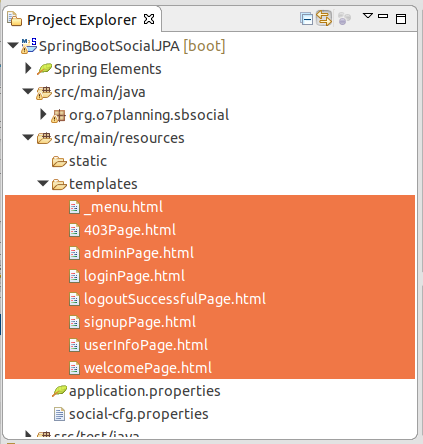
_menu.html
<div xmlns:th="http://www.thymeleaf.org"
style="border: 1px solid #ccc;padding:5px;margin-bottom:20px;">
<a th:href="@{/}">Home</a>
|
<a th:href="@{/userInfo}">User Info</a>
|
<a th:href="@{/admin}">Admin</a>
|
<a th:if="${#request.userPrincipal != null}" th:href="@{/logout}">Logout</a>
</div>403Page.html
<!DOCTYPE HTML>
<html xmlns:th="http://www.thymeleaf.org">
<head>
<title>Access Denied</title>
</head>
<body>
<!-- Include _menu.html -->
<th:block th:include="/_menu"></th:block>
<h3 th:if="${message != null}" th:utext="${message}" style="color: red;"></h3>
<div th:if="${userInfo != null}" th:utext="${userInfo}"></div>
</body>
</html>adminPage.html
<!DOCTYPE HTML>
<html xmlns:th="http://www.thymeleaf.org">
<head>
<title th:utext="${title}"></title>
</head>
<body>
<!-- Include _menu.html -->
<th:block th:include="/_menu"></th:block>
<h2>Admin Page</h2>
<h3>Welcome :
<span th:utext="${#request.userPrincipal.name}"></span>
</h3>
<b>This is protected page!</b>
<br/><br/>
<div th:if="${userInfo != null}" th:utext="${userInfo}"></div>
</body>
</html>loginPage.html
<!DOCTYPE HTML>
<html xmlns:th="http://www.thymeleaf.org">
<head>
<title>Login</title>
</head>
<body>
<!-- Include _menu.html -->
<th:block th:include="/_menu"></th:block>
<h1>Login</h1>
<h2>Social Login</h2>
<a th:href="@{/auth/facebook}">Face Book</a>
<br />
<a th:href="@{/auth/google}">Google</a>
<br />
<!-- /login?error=true -->
<div th:if="${#request.getParameter('error') == 'true'}"
style="color:red;margin:10px 0px;">
Login Failed!!!<br />
Reason :
<span th:if="${#session!= null and #session.getAttribute('SPRING_SECURITY_LAST_EXCEPTION') != null}"
th:utext="${#session.getAttribute('SPRING_SECURITY_LAST_EXCEPTION').message}">
Static summary
</span>
</div>
<h3>Enter user name and password:</h3>
<form name='f' th:action="@{/j_spring_security_check}" method='POST'>
<table>
<tr>
<td>User:</td>
<td><input type='text' name='username' value=''></td>
</tr>
<tr>
<td>Password:</td>
<td><input type='password' name='password' /></td>
</tr>
<tr>
<td>Remember Me?</td>
<td><input type="checkbox" name="remember-me" /></td>
</tr>
<tr>
<td><input name="submit" type="submit" value="submit" /></td>
</tr>
</table>
</form>
<br>
Username/pass:
<ul>
<li>dbuser1/123</li>
<li>dbadmin1/123</li>
</ul>
</body>
</html>loginSuccessfulPage.html
<!DOCTYPE HTML>
<html xmlns:th="http://www.thymeleaf.org">
<head>
<title>Logout</title>
</head>
<body>
<!-- Include _menu.html -->
<th:block th:include="/_menu"></th:block>
<h1>Logout Successful!</h1>
</body>
</html>signupPage.html
<!DOCTYPE HTML>
<html xmlns:th="http://www.thymeleaf.org">
<head>
<meta charset="UTF-8">
<title>Sign Up</title>
<style>
.error-message {
font-size:90%;
font-style:italic;
color:red;
}
</style>
</head>
<body>
<!-- Include _menu.html -->
<th:block th:include="/_menu"></th:block>
<h1>Register</h1>
<h2 style="color:blue;"
th:if="${myForm.signInProvider != null}">Signup with <span th:utex="${myForm.signInProvider}"></span></h2>
<form th:object="${myForm}" method="POST">
<input type="hidden" th:field="*{userId}" />
<input type="hidden" th:field="*{signInProvider}" />
<table border="0">
<tr>
<td>User Name</td>
<td><input th:field="*{userName}" /></td>
<td>
<span class="error-message"
th:if="${#fields.hasErrors('userName')}" th:errors="*{userName}">..</span>
</td>
</tr>
<tr>
<td>Email</td>
<td><input th:field="*{email}" /></td>
<td>
<span class="error-message"
th:if="${#fields.hasErrors('email')}" th:errors="*{email}">..</span>
</td>
</tr>
<tr>
<td>First Name</td>
<td><input th:field="*{firstName}" /></td>
<td>
<span class="error-message"
th:if="${#fields.hasErrors('firstName')}" th:errors="*{firstName}">..</span>
</td>
</tr>
<tr>
<td>Last Name</td>
<td><input th:field="*{lastName}" /></td>
<td>
<span class="error-message"
th:if="${#fields.hasErrors('lastName')}" th:errors="*{lastName}">..</span>
</td>
</tr>
<tr>
<td>Password</td>
<td><input th:field="*{password}" /></td>
<td>
<span class="error-message"
th:if="${#fields.hasErrors('password')}" th:errors="*{password}">..</span>
</td>
</tr>
<tr>
<td></td>
<td><input type="submit" value="Submit" /></td>
<td></td>
</tr>
</table>
</form>
<div class="error-message" th:utext="${errorMessage}"></div>
</body>
</html>userInfoPage.html
<!DOCTYPE HTML>
<html xmlns:th="http://www.thymeleaf.org">
<head>
<title>User Info</title>
</head>
<body>
<!-- Include _menu.html -->
<th:block th:include="/_menu"></th:block>
<h2>User Info Page</h2>
<h3>Welcome : <span th:utext="${#request.userPrincipal.name}"></span></h3>
<b>This is protected page!</b>
<br/><br/>
<div th:if="${userInfo != null}" th:utext="${userInfo}"></div>
</body>
</html>welcomePage.html
<!DOCTYPE HTML>
<html xmlns:th="http://www.thymeleaf.org">
<head>
<title th:utext="${title}"></title>
</head>
<body>
<!-- Include _menu.html -->
<th:block th:include="/_menu"></th:block>
<h2>Message : <span th:utext="${message}"></span></h2>
</body>
</html>Spring Boot Tutorials
- Install Spring Tool Suite for Eclipse
- Spring Tutorial for Beginners
- Spring Boot Tutorial for Beginners
- Spring Boot Common Properties
- Spring Boot and Thymeleaf Tutorial with Examples
- Spring Boot and FreeMarker Tutorial with Examples
- Spring Boot and Groovy Tutorial with Examples
- Spring Boot and Mustache Tutorial with Examples
- Spring Boot and JSP Tutorial with Examples
- Spring Boot, Apache Tiles, JSP Tutorial with Examples
- Use Logging in Spring Boot
- Application Monitoring with Spring Boot Actuator
- Create a Multi Language web application with Spring Boot
- Use multiple ViewResolvers in Spring Boot
- Use Twitter Bootstrap in Spring Boot
- Spring Boot Interceptors Tutorial with Examples
- Spring Boot, Spring JDBC and Spring Transaction Tutorial with Examples
- Spring JDBC Tutorial with Examples
- Spring Boot, JPA and Spring Transaction Tutorial with Examples
- Spring Boot and Spring Data JPA Tutorial with Examples
- Spring Boot, Hibernate and Spring Transaction Tutorial with Examples
- Integrating Spring Boot, JPA and H2 Database
- Spring Boot and MongoDB Tutorial with Examples
- Use Multiple DataSources with Spring Boot and JPA
- Use Multiple DataSources with Spring Boot and RoutingDataSource
- Create a Login Application with Spring Boot, Spring Security, Spring JDBC
- Create a Login Application with Spring Boot, Spring Security, JPA
- Create a User Registration Application with Spring Boot, Spring Form Validation
- Example of OAuth2 Social Login in Spring Boot
- Run background scheduled tasks in Spring
- CRUD Restful Web Service Example with Spring Boot
- Spring Boot Restful Client with RestTemplate Example
- CRUD Example with Spring Boot, REST and AngularJS
- Secure Spring Boot RESTful Service using Basic Authentication
- Secure Spring Boot RESTful Service using Auth0 JWT
- Spring Boot File Upload Example
- Spring Boot File Download Example
- Spring Boot File Upload with jQuery Ajax Example
- Spring Boot File Upload with AngularJS Example
- Create a Shopping Cart Web Application with Spring Boot, Hibernate
- Spring Email Tutorial with Examples
- Create a simple Chat application with Spring Boot and Websocket
- Deploy Spring Boot Application on Tomcat Server
- Deploy Spring Boot Application on Oracle WebLogic Server
- Install a free Let's Encrypt SSL certificate for Spring Boot
- Configure Spring Boot to redirect HTTP to HTTPS
- Fetch data with Spring Data JPA DTO Projections
Show More